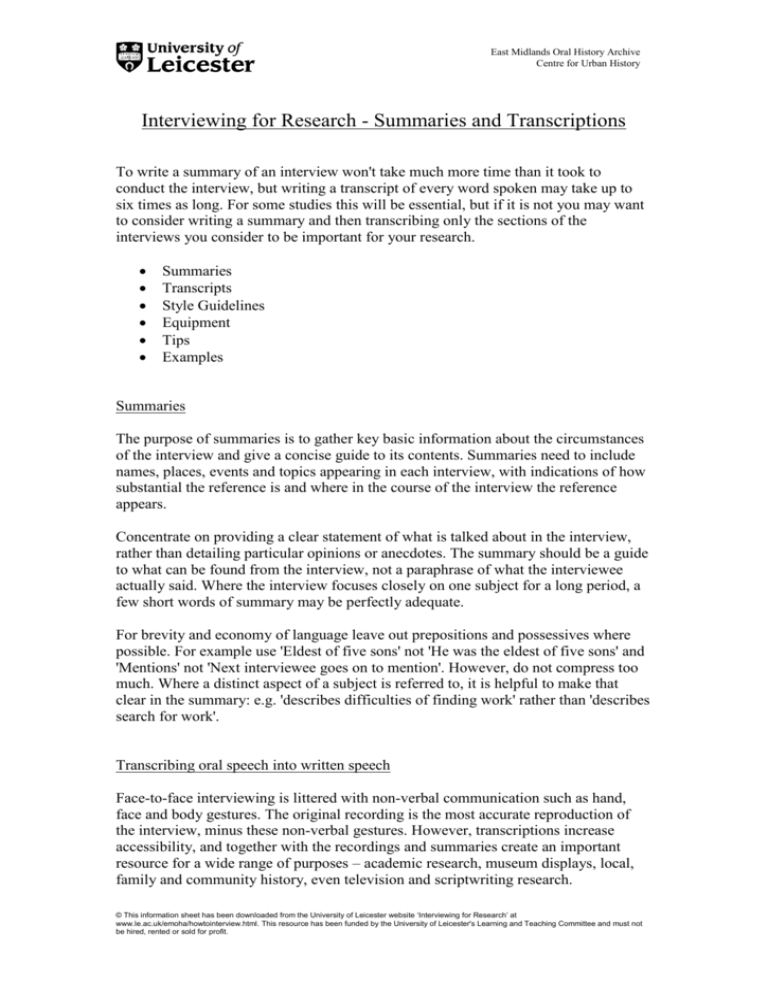Summaries and Transcriptions
advertisement

East Midlands Oral History Archive Centre for Urban History Interviewing for Research - Summaries and Transcriptions To write a summary of an interview won't take much more time than it took to conduct the interview, but writing a transcript of every word spoken may take up to six times as long. For some studies this will be essential, but if it is not you may want to consider writing a summary and then transcribing only the sections of the interviews you consider to be important for your research. Summaries Transcripts Style Guidelines Equipment Tips Examples Summaries The purpose of summaries is to gather key basic information about the circumstances of the interview and give a concise guide to its contents. Summaries need to include names, places, events and topics appearing in each interview, with indications of how substantial the reference is and where in the course of the interview the reference appears. Concentrate on providing a clear statement of what is talked about in the interview, rather than detailing particular opinions or anecdotes. The summary should be a guide to what can be found from the interview, not a paraphrase of what the interviewee actually said. Where the interview focuses closely on one subject for a long period, a few short words of summary may be perfectly adequate. For brevity and economy of language leave out prepositions and possessives where possible. For example use 'Eldest of five sons' not 'He was the eldest of five sons' and 'Mentions' not 'Next interviewee goes on to mention'. However, do not compress too much. Where a distinct aspect of a subject is referred to, it is helpful to make that clear in the summary: e.g. 'describes difficulties of finding work' rather than 'describes search for work'. Transcribing oral speech into written speech Face-to-face interviewing is littered with non-verbal communication such as hand, face and body gestures. The original recording is the most accurate reproduction of the interview, minus these non-verbal gestures. However, transcriptions increase accessibility, and together with the recordings and summaries create an important resource for a wide range of purposes – academic research, museum displays, local, family and community history, even television and scriptwriting research. © This information sheet has been downloaded from the University of Leicester website ‘Interviewing for Research’ at www.le.ac.uk/emoha/howtointerview.html. This resource has been funded by the University of Leicester's Learning and Teaching Committee and must not be hired, rented or sold for profit. Turning a recording into written speech is sometimes akin to an act of translation, not just editing. There is no consensus on how to perform the task, but there are some ethical guidelines you should follow: Do not correct interviewees’ words or grammar, do not change speech patterns. Do not change content, intent or put words in the interviewee’s mouth. Style Guidelines You could transcribe every pause, every ‘um’ and ‘ahh’ but this makes for clumsy reading. It’s probably best to only include those that convey something of the interviewee’s speech. Nominate one standard dictionary for the project, and set guidelines for spelling so that, for example, regional words are spelled consistently. Standardise font, print size, line spacing, paragraphing, use of quotation marks, use of upper and lower case letters, how to indicate years, time and numbers, to abbreviate, and hyphenate words (e.g. cooperation/co-operation). Place certain recorded activities into square brackets e.g. [laughs], [phone rings]. Unintelligible parts of the recording? Listen carefully. Get someone else to listen. Type what you think it says and add [??] or add or [unclear]. Use dashes – for pauses – interruptions – and incomplete sentences. Feedback words and sounds such as “uh huh,” “yes” and “hmm”— interviewers use them to engage with the interviewee but can make transcripts tedious to read. Use your judgement when to leave these out. Crutch words—e.g. ‘uh’ after single words in a row. Don’t transcribe if it makes reading difficult, unless it is an important part of the narrator’s speech pattern. Equipment Transcribing machines with a foot pedal leave your hands free for writing or typing, but an ordinary playback machine with a pause button is adequate. Comfortable headphones are a must for lengthy transcribing sessions—the little ones that fit just inside your ears are perhaps best avoided. Typing into a word processor will help speed things up. And remember—transcribing can be physically demanding. Make sure your equipment and seating is comfortable to use, and take regular breaks. You may also want to consider software which is available to make transcribing via your computer more easy. One such package is Express Scribe, which is available free on the web at http://www.nch.com.au/scribe/ . Tips Head your summaries and transcriptions with relevant identifying names and/or codes, otherwise you won’t know which recordings they belong to. If other people are © This information sheet has been downloaded from the University of Leicester website ‘Interviewing for Research’ at www.le.ac.uk/emoha/howtointerview.html. This resource has been funded by the University of Leicester's Learning and Teaching Committee and must not be hired, rented or sold for profit. to have access to the summaries and transcriptions, make sure you adhere to any restrictions placed on the material by the interviewee (e.g. they may not wish to be identified by name). Do not disclose any other information such as addresses or telephone numbers. Offer interviewees the chance to review the relevant summary and transcription. They might be able to clarify names, places, and other information. Transcribing can be very time-consuming, varying between 4 to 10 hours transcribing per hour of recorded interview, depending on skill and equipment. If time is short or if you only want to use certain sections, transcribe selected extracts. At the planning stage of the project, be sure to include a realistic amount of time for the task. Professional transcription may be expensive. Do you have funding to pay for it? Did you include the costs in your planning? If not, you’ll need someone with the time and necessary skills/equipment. Whoever does the job, someone else must go through the text whilst listening to the recording to check for accuracy. And if you are sending the recording away to be transcribed, don’t send your original tapes! Example of a summary 02186/S, EM/121 EMOHA Project Collection Interviewee: Name withheld b. 1921 Newton Burgoland, Leicestershire Occupation: Shop assistant, catering Interview Dates: 26/07/2001, 06/09/2001, 11/10/2001 NOTE: Interviewee and husband’s names have been edited out of the interview CD 1 Track 1 Infants’ class 1:00 Cleaning School 2:00 School toilets 3:06 Recalls Infants’ class. Slates and pencils that squeaked. Grandma was caretaker. Before school holidays, Miss Oakey, the teacher, bought box of sweets to share around infants’ class. Age 7: moved into ‘middle’ class. Describes school cleaning. One piano for three classes. No central heating. Coal fire and guard. Later, a stove. Big boiler at side of school. Grandfather stoked boiler. Grandma cleaned school Friday night. Recalls helping to clean brass taps on washbasins; grandma gave her 6d for helping. Describes toilets in schoolyard—one locked for staff. Men emptied the pans (metal pans/wooden seats) once a week. Horrible to use. Had same at home—but lovely white seat—father buried contents in fields. Was “a bit finicky”. © This information sheet has been downloaded from the University of Leicester website ‘Interviewing for Research’ at www.le.ac.uk/emoha/howtointerview.html. This resource has been funded by the University of Leicester's Learning and Teaching Committee and must not be hired, rented or sold for profit. Example of a transcript 02186/S, EM/121 EMOHA Project Collection Interviewee: Name withheld b. 1921 Newton Burgoland, Leicestershire Occupation: Shop assistant, catering Interview Dates: 26/07/2001, 06/09/2001, 11/10/2001 Interviewee: There were, there was the infants' room. Next to that was the middle one, school, and then you went up into the next one, which was, into the next room, which was divided by a screen. That was all that it was. Just a screen across the… EMOHA: What was the… Interviewee: So if the headmaster shouted while we were in this class you could hear every word of what he was saying. Anybody got the cane, you could hear it. EMOHA: What was the dividing wall for, or screen for? Interviewee: Well, it was so that if there was an assembly of any kind, it could be opened but it didn't happen very often, only when the school was hired for the village, local village show or something like that. We had one piano for those three classes and of course there were no central heating then and we had a coal fire in the, with a guard round it. Then it eventually got to a stove, and I think before I left school, the school, I think all that was done away with and it was central heating then. But the other heat was from a big boiler at the side of the school which my grandfather used to stoke morning and evening, and that kept the hot water going. And on Friday nights my grandma had to clean the school thoroughly and we used to go, my sister and I, and they were brass taps on the wash basins, and we used to go and polish the brass taps for her and do all the wash basins and she used to give us sixpence each for doing that. EMOHA: So, what sort of toilet facilities did they have at school? Interviewee: They were in the school yard. There was a row of them. There was one kept locked for the staff. There was the girls' side and then there was a high wall and then there was the boys' side, and of course, they were, they had the men come and empty the pans once a week. EMOHA: When you say "empty the pans"… Interviewee: Never conscious of it being done but it was always done. EMOHA: What sort of pans were these? Interviewee: Well, they were metal pans into wooden seats, you see. EMOHA: So, each toilet…? Interviewee: Had a wooden seat and metal pan. EMOHA: Can you … Interviewee: No chains or anything. EMOHA: Can you remember what they were like to use? Interviewee: Horrible. Well, I thought they were. EMOHA: Was that very different to what you had at home? What sort of toilet did you have at home? Interviewee: Oh no, we had the same thing at home! Oh yes. Lovely white seat because my sister and I used to scrub it. EMOHA: What happened to the pan at home? Interviewee: My father emptied that. That went down the fields. EMOHA: Did it? Interviewee: Buried. So we never had an accumulation, it was always kept very nice. EMOHA: So, the school ones weren't, you said they weren't, you didn't like using them? Interviewee: I didn't like it but then I was a bit finicky anyway. © This information sheet has been downloaded from the University of Leicester website ‘Interviewing for Research’ at www.le.ac.uk/emoha/howtointerview.html. This resource has been funded by the University of Leicester's Learning and Teaching Committee and must not be hired, rented or sold for profit. Useful websites The Baylor University Institute for Oral History transcribing ‘style guide’: http://www.baylor.edu/Oral_History/Workshop_welcome.html Minnesota Historical Society Guidelines: http://www.mnhs.org/collections/oralhistory/ohtranscribing.pdf The Veterans’ History Project: http://www.loc.gov/folklife/vets/transcribe.html © This information sheet has been downloaded from the University of Leicester website ‘Interviewing for Research’ at www.le.ac.uk/emoha/howtointerview.html. This resource has been funded by the University of Leicester's Learning and Teaching Committee and must not be hired, rented or sold for profit.






